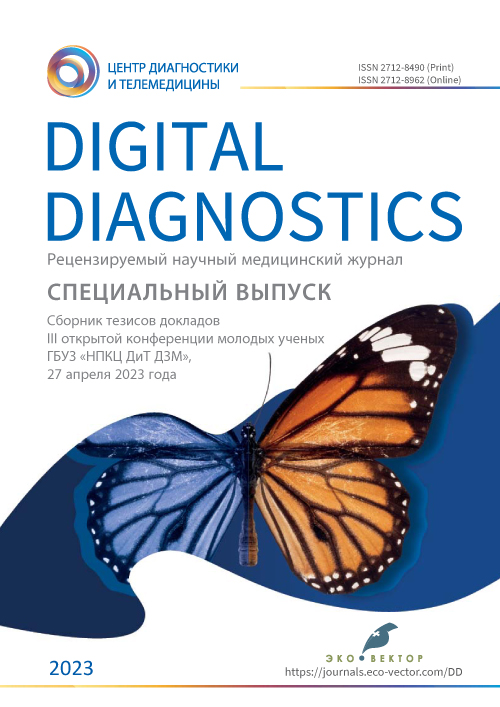Ultrasonic elastographic and morphological features of fatty hepatosis
- Авторлар: Rashidova K.A.1
-
Мекемелер:
- Samarkand State Medical University
- Шығарылым: Том 4, № 1S (2023)
- Беттер: 111-112
- Бөлім: Conference proceedings
- ##submission.dateSubmitted##: 18.05.2023
- ##submission.dateAccepted##: 18.05.2023
- ##submission.datePublished##: 26.06.2023
- URL: https://jdigitaldiagnostics.com/DD/article/view/430362
- DOI: https://doi.org/10.17816/DD430362
- ID: 430362
Дәйексөз келтіру
Толық мәтін
Аннотация
BACKGROUND: Non-alcoholic fatty liver disease is a common chronic liver condition characterized by pathological accumulation of fatty droplets, which is not associated with alcohol consumption. The main reason in the development of complications and adverse outcomes of the disease is fibrotic changes in the liver, leading to cirrhosis.
AIM: To determ the informative value of two-dimensional shear wave elastography in hepatosis by a comparative analysis of morphological and ultrasound elastometric findings.
METHODS: The study included 40 patients aged 35–60 years. The control group consisted of 25 healthy people with a body mass index of 24–26. Among 40 patients, F1, F2 and F3 stages were detected in 15 (37.5%), 20 (50%), and 5 (12.5%) cases, respectively. The diagnosis was based on clinical, laboratory, and ultrasound examinations conducted with a Mindray Consona N9 device using a convex transducer at 2.0–3.5 MHz. In the absence of contraindications, all patients underwent puncture biopsy under ultrasound navigation in compliance with aseptic and antiseptic requirements.
RESULTS: At the first (F1) stage of hepatic fibrosis (n=15), the elastometry index averaged 5.4 (4.8–6.2) kPa, and the shear wave velocity was 1.1±0.2 m/s. Histomorphological examination in this group revealed mild fatty liver dystrophy, with liver tissue having varying degrees of dystrophic changes. In the second (F2) stage of fibrosis (n=20), the mean elastometry values were 6.9 (6.3–7.9) kPa, while the shear wave velocity increased to 1.5±0.2 m/s. In patients of this group, histological examination showed that moderate to large fatty dystrophy developed in hepatocytes. In the F3 stage (n=5), the elastometry index averaged 8.3 (8.1–13.5) kPa, and the shear wave velocity reached 1.7±0.2 m/s. In this case, hepatocytes with fatty dystrophy in the focus surrounded by a cluster of lipophages were determined. Coincidence of fibrosis stage determined by elastometry data with morphological examination of liver biopsy specimen was observed in 36 (90%) patients with fatty hepatosis.
CONCLUSIONS: Comparison of the results of two-dimensional shear wave elastography and morphological changes of liver parenchyma in hepatosis showed high (90%) correlation with the data of the above examinations. If puncture biopsy is contraindicated, shear wave elastography may serve as a valuable diagnostic method to clarify the stage of fibrosis in hepatosis.
Негізгі сөздер
Толық мәтін
BACKGROUND: Non-alcoholic fatty liver disease is a common chronic liver condition characterized by pathological accumulation of fatty droplets, which is not associated with alcohol consumption. The main reason in the development of complications and adverse outcomes of the disease is fibrotic changes in the liver, leading to cirrhosis.
AIM: To determ the informative value of two-dimensional shear wave elastography in hepatosis by a comparative analysis of morphological and ultrasound elastometric findings.
METHODS: The study included 40 patients aged 35–60 years. The control group consisted of 25 healthy people with a body mass index of 24–26. Among 40 patients, F1, F2 and F3 stages were detected in 15 (37.5%), 20 (50%), and 5 (12.5%) cases, respectively. The diagnosis was based on clinical, laboratory, and ultrasound examinations conducted with a Mindray Consona N9 device using a convex transducer at 2.0–3.5 MHz. In the absence of contraindications, all patients underwent puncture biopsy under ultrasound navigation in compliance with aseptic and antiseptic requirements.
RESULTS: At the first (F1) stage of hepatic fibrosis (n=15), the elastometry index averaged 5.4 (4.8–6.2) kPa, and the shear wave velocity was 1.1±0.2 m/s. Histomorphological examination in this group revealed mild fatty liver dystrophy, with liver tissue having varying degrees of dystrophic changes. In the second (F2) stage of fibrosis (n=20), the mean elastometry values were 6.9 (6.3–7.9) kPa, while the shear wave velocity increased to 1.5±0.2 m/s. In patients of this group, histological examination showed that moderate to large fatty dystrophy developed in hepatocytes. In the F3 stage (n=5), the elastometry index averaged 8.3 (8.1–13.5) kPa, and the shear wave velocity reached 1.7±0.2 m/s. In this case, hepatocytes with fatty dystrophy in the focus surrounded by a cluster of lipophages were determined. Coincidence of fibrosis stage determined by elastometry data with morphological examination of liver biopsy specimen was observed in 36 (90%) patients with fatty hepatosis.
CONCLUSIONS: Comparison of the results of two-dimensional shear wave elastography and morphological changes of liver parenchyma in hepatosis showed high (90%) correlation with the data of the above examinations. If puncture biopsy is contraindicated, shear wave elastography may serve as a valuable diagnostic method to clarify the stage of fibrosis in hepatosis.
Авторлар туралы
Khurshida Rashidova
Samarkand State Medical University
Хат алмасуға жауапты Автор.
Email: Xurshida410@gmail.com
ORCID iD: 0009-0001-5532-3267
Өзбекстан, Samarkand
Әдебиет тізімі
- Arisheva O.S., Garmash I.V., Kobalova Zh.D., Moiseev V.S. Metody diagnostiki fibroza pecheni. Experimental and Clinical Gastroenterology. 2013;(7):49–55. (In Russ).
- Borsukov AV, editor. Ul’trazvukovaya elastografiya: kak delat’ pravil’no. Smolensk; 2018. 120 p. (In Russ).
- Shirokova EN, Pavlov ChS, Karaseva AD, et al. Elastography in the Diagnosis of Non-Alcoholic Fatty Liver Disease // Annals of the Russian Academy of Medical Sciences. 2019;74(1):5–13. (In Russ).
Қосымша файлдар










